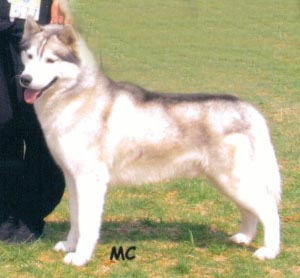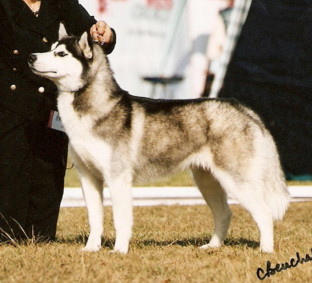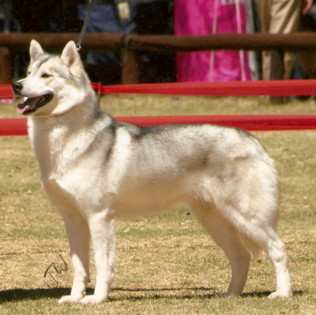SIBERIAN HUSKY BREED INFORMATION
The following information is a basic description of the breed for the novice enthusiast and my personal understanding of the Siberian Husky, through years of living with them, observing their interaction in a pack, habits, traits, formidable energy and power and above all their incredible athletic beauty and gentle character
Brief Description
The Siberian Husky is a medium sized dog in all aspects of its body proportions. It originates from Siberia and was brought across the Bering Straits into Alaska in the early 1900's. The purpose of the breed was to pull sleds over long distances at a moderately fast trot.
Appearance
The Siberian Husky has a wolf -like resemblance, but is far more refined in appearance, smaller in size and friendly, with pack orientated behavioral habits. It does not like to live alone. It is an athletic looking dog, females being smaller and more refined than the males.

It has a double coat with the outer coat, known as guard coat, being slightly longer and courser than the soft plush undercoat. The Siberian Husky tends to shed it's coat at least once a year, but more so in bitches (possibly twice a year) when they are about to come into season. Males tend to maintain their coat for longer periods, depending on weather conditions. If you suffer from allergies, this is not the breed for you.

Grey and white Red & white (chocolate) Piebald puppy Black and white (dilute)
The Siberian Husky comes in various colours with differente types of masks . The coat colour is determined by the shade of its mask on the head. There is black and white, red and white, grey and white, white and piebalds of differente shades. The reds have various shades from rich chocolate to pale light red/peach colour. The grey's range from dark wolf grey to pale silver grey. The black and white may be diluted to give an impression of a dark grey or it may be pitch black. Piebalds have a basic white coat with splashes or spots of one color on the body and head. The coat protects and insulates the Siberian both from cold and hot weather conditions.
B/W with blue eyes Grey with brown eyes B/W with parti-colored eyes
The eyes of the Siberian Husky are almond shaped and slightly oblique. The colours may be blue, brown, parti-colored (blue and brown in one eye) or by-eyed (one blue, one brown). The red dogs have amber eyes instead of brown.
The muzzle is of medium width tapering to the nose. The stop is well defined. The skull is slightly rounded with high set well furred triangular ears. Lips are close fitting and teeth must close in a scissor bite.
The pigmentation on a black and white or grey Siberian Husky is black. The pigmentation on the red dog is brown.
Body
The body of the Siberian is slightly longer than it is tall with the tail ending in a sickle curve. When in motion the tail trails behind in line with the body and when in repose the tail hangs loosely.
The Siberian Husky is a well angulated, balanced, medium sized dog with an arched neck, good layback of shoulder, angled upper arm, deep chest, straight top line (back), tuck-up, angled croup and well bent stifles to match the front assembly. The legs are slightly longer than the body width (that is from elbow to withers), straight and moderately spaced with low to ground straight hooks with all feet facing forward . The feet are oval in shape and tight fitting.

Gait
The Siberian Husky should move effortlessly with elegance and power It must give the impression of being quick and light on its feet with good reach and drive. This breed must single track.

The most important trait in the Siberian Husky Breed - effortless movement!
For specific and detailed information on the standard of the Siberian Husky, please refer to the Siberian Husky Club of America for the American Kennel Club Breed Standard.
Behaviour
Unlike other dog breeds, the Siberian Husky is very friendly and definitely not a guard dog, although it may awake the neighbours with its friendly welcoming howl and occasional bark. They should never show aggression to humans, but may be aloof and independent in their behaviour.
As a puppy, the Siberian Husky is a keen gardener and landscaper. It loves to dig, eat flowers, pull bark off trees and so on. They also love to steal, if given the opportunity. Many pairs of socks and other clothing, soap, toilet paper, tissues, magazines and food left on counters have disappeared without a trace. Later in life, they tend to relax, with less frequent outbursts of childish behaviour and boundless energy.
Their incredible desire to run is soon noticed, if gates are left open or walls are too low. They will try and jump and they will bolt out of your gate while you are trying to enter the premises or park the car, and they will run, run, run! If your property is not secure enough, this is not the breed for you. Never let your Siberian Husky run off lead. It may never come back.
This breed loves human company and should not be left on its own or locked up outside. It should at least have a playmate, preferably of the opposite sex, neutered or spayed, as once boredom sets in, they can become quite destructive and very noisy. They make lovely family pets and love to play with children, although they are rather boisterous and should be supervised at all times, when in the company of little people.
The Siberian Husky is very much like a child in character, always taking chances, pushing you that much further and if possible, taking over. But, he is also oh so beautiful, loving and happy by nature. This is a pack dog and therefore requires canine companionship. Never scold an adult Siberian that is trying to discipline a younger one. Although a puppy may scream as a defense mechanism, he will not get hurt in the process. This is the natural process of integration of a puppy into the pack and the understanding of it's place in that order.
They are not good at obedience, although in some cases some have excelled, this is not the norm. My Siberians do listen to me and are fully house trained, but it does not come easy. It has taken time, years of understanding dog behaviour, discipline and tremendous patience on both our sides to maintain this kind of harmony in such a large pack as my own.
Feeding
The Siberian Husky is a very low cost breed to feed. They eat less than most other breeds. Your premium maintenance dog food diets available from VETS and some supermarkets/pet deli's, are sufficient for the not so active house dog. I find that most young Siberians do best with high fat, high protein diets. As the Siberian enters his veteran years, I prefer less fat, but still a high amount of protein. I have tried every food there is on the market, over the years and can through experience recommend a number of products and do's and dont's . Brands of foods I recommend to keep a Siberian Husky in Top Condition and for the Siberian Puppy:
Propac, Eukanuba, Royal Canin, Hills Science diet, Bento Kronin, Purina Proplan.
Of the SA brands on the market for the pet owner and for middle aged Siberians the following:
Olympic, York Super adult only, Pedigree, Dogsense High Performance, Ultra Dog and Vets choice.
Every dog has a different anatomy and build and therefore some products will work better for specific cases. If your dog is fat do not feed it a high fat content diet and look for a food low on fat. The protein and fat content is stipulated in each bag. What is appropriate for human nutrition and consumption is not necessarily good for your dog. "Good quality" dog food is an essential part of a siberian's well being. Please remember that dogs are lactose intolerant, so do not give them milk as a treat. Chocolates and onions are poisonous to their system. Bread and mealie meal are useless to their nutrition.
The best treat you can give your Siberian and should always do so, is big sized RAW meaty bones!
Puppies should be fed on puppy food 3 times a day until they are at least 4 months. Thereafter twice a day until a year of age. As an adult, switch to adult food and feed once a day. You may divide the food into two portions and feed half in the morning and the other half at night.
If you have more than one dog, always feed the older dog first, down to the youngest. That way the pack order is maintained.
Grooming
This is a very clean breed. No "doggy" smell should be present. A certain amount of grooming is required during the shedding season.
To loosen the coat, you may bathe the dog in warm water and blow dry the hair loose. This promotes shedding. Brush the coat with a long toothed comb to remove loose hair. The longer you leave the coat on the dog, the longer it will take for a new coat to grow back.
The rest of the year, your Siberian should be fine. You may brush the coat as often as you wish, but too much bathing removes the natural oils from the coat, so refrain until absolutely necessary. Siberian Huskies generally keep themselves very clean and do not like to be dirty. Next time your Siberian appears at the back door covered in mud, don't worry. Leave him outside and go to bed. By tomorrow morning, he will be all clean again. I don't know how they do it.
Genetic Disorders
Although the Siberian Husky is generally a hardy and healthy breed, there are a few hereditary genetic problems that breeders all over, have repeatedly encountered through the years. If you plan on breeding your Siberian Husky, please make sure his eyes are tested for cataracts, glaucoma and other abnormalities. Eyes are a big problem in this breed. The other genetic disorder is Hip-Dysplasia and I believe that all breeding stock should be tested. Lastly but not least, Epilepsy which has become quite a problem in some lines. Never breed with dogs that are affected with any of the above mentioned genetic disorders.
Sledding in South Africa
We work our dogs only in winter with temperatures of 5 degrees centigrade and below.
Our equipment consists of three or four wheel custom made carts with the usual gangline and harnesses. Most of my harnesses come from the United States, but we have now started making them here. I make my own neck and ganglines.
You may run your dogs in harness pulling you on a bicycle or cart. If you are going to use a cart, I suggest you use 2 or more dogs. Always make sure you are in control of your dogs or they will take you for a spin in the field, at the sight of a guinea fowl or dashing rabbit. There is nothing more rewarding than a well behaved team of Siberian Huskies.
This sport is slowly gaining a tremendous amount of popularity in South Africa and a few sled dog clubs have formed in other parts of the country to enforce the true legacy of the Siberian Husky breed.
view photos Sledding in winter
NB: Siberian Huskies in Africa
Siberian Huskies have no immunity to tick bite fever and can die from it. They must be kept free of these parasites at all times. Please dip you Siberian Husky regularly or use Frontline spray or spot on. Also keep your vaccinations up to date. It is very important.
For more info Visit the Siberian Husky Club of America
Also visit Health Information for pets
Make sure there is shade and water available at all times and that your property is well secure and Siberian safe.
Lastly, but not least, love your Siberian Husky!
They are the best!!!
PEACE ON EARTH